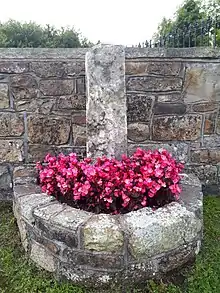Cloonmorris Ogham stone
The Cloonmorris Ogham Stone is an ancient monument at Saint Michael's Church, Bornacoola, County Leitrim, in Ireland.

Description
It is the only Ogham inscribed stone to be recorded in County Leitrim. First examined by Mac Neill in 1909, the stone then marked the Kellagher family burial plot "opposite the middle of the eastern gable of the ruin" of Cloonmorris church. The c. 0.85m long stone dates to c. 400 – c. 550, has an ecclesiastical association, and is not definitely post-apocope.[1][2]
The defaced inscription makes accurate reading difficult. The inscription reads G..T..........QENUVEN,[1] or QENUVEN[--, expanding to "QENUVEN[DI--" and translating to "QVENVENDANI", "(hair of the) head" + "fair" + diminutive suffix.[2] Korlev interpreted the inscription as "G(A)T[TAGNI MAQI MUCOI (?)] QENUVEN[DI]" while Gippert (1978) suggested the inscription was "QENOVENAGNI MAQI C MUCOI LUGUDDECCAS" marking the genealogy Cenannяn m. Ceise m. Lugdech?[3]
MacNeill thought the stone was probably the memorial of one Qenuvin-dagnas (Irish: Ceanannán, Ceannán). In Wales the name Qennovindagni occurs on a British-Latin inscription at Parcau near Whitland in Carmarthenshire,[4] and is believed to identify a person of Gaelic, rather than Brythonic, origin.[5][n 1] Scholars noted the Cloonmorris is "hardly a stone's throw from the boundary" between Longford and Leitrim, the stone standing inside the historic Conmhaícne territory once separating the Kingdom of Meath from Connacht.[3]
In 1978 the stone was moved and enclosed on a pedestal near the churchyard entrance, but in doing so was placed into an inverted (top-down) position.[3]
Notes and references
Notes
- In Ireland "Saint Ceanannan" has a feast day of March 29,[6] but another Saint named "Cenannán m. Áil of the Airgialla" is also recorded.[7] The Saint "Sinchell (Sinell) the Elder" of Offaly (and Leitrim) was supposedly a son of "Ceanannan" (The Annals of the Four Masters states- 548: St. Sincheall the elder, son of Ceanannan, Abbot of Cill Achaidh Dromafoda, died on the twenty sixth day of March. Thirty and three hundred years was the length of his life).[8]
Citations
- Swift 2002, pp. 134-5,137.
- Davies, Graham-Campbell 1999, pp. CLOOM/1.
- Gippert 1996.
- Davies, Graham-Campbell 1999, pp. HENLL/1.
- MacNeill 1909, pp. 135.
- O'Clery 1864, pp. 88.
- Clancy 2013.
- AFM.
References
- Davies, Graham-Campbell, ed. (1999). "Celtic Inscribed Stones" (CLOOM/1 ed.). University College London.CS1 maint: ref=harv (link)
- Davies, Graham-Campbell, ed. (1999). "Celtic Inscribed Stones" (HENLL/1 ed.). University College London.CS1 maint: ref=harv (link)
- Swift, Catherine (2002). Timoney, M.A. (ed.). Ogam Stones in Sligo and their Context. Celebration of Sligo: First Essays for Sligo Field Club. Sligo: Sligo Field Club. pp. 127–140.CS1 maint: ref=harv (link)
- MacNeill, John (1909). "Ogham Inscription at Cloonmorris, Co. Leitrim" (PDF). The Journal of the Royal Society of Antiquaries of Ireland. Proceedings and papers. Vol. XXXIX (Fifth series ed.). Royal Society of Antiquaries of Ireland: 132–136. Cite journal requires
|journal=(help)CS1 maint: ref=harv (link) - Gippert, Jost (1996). "Ogam Inscription: CIIC no. 002". TITUS, Information Center of the Society for Indo-European Studies.CS1 maint: ref=harv (link)
- Clancy, Thomas Owen (2013). "Cenannán m. Áil of the Airgialla". University of Glasgow's School of Humanities (Celtic & Gaelic, and HATII).CS1 maint: ref=harv (link)
- Annals of the Four Masters, ed. & tr. John O'Donovan (1856). Annála Rioghachta Éireann. Annals of the Kingdom of Ireland by the Four Masters... with a Translation and Copious Notes. 7 vols (2nd ed.). Dublin: Royal Irish Academy. CELT editions. Full scans at Internet Archive: Vol. 1; Vol. 2; Vol. 3; Vol. 4; Vol. 5; Vol. 6; Indices.